How good are birthdays?
Like watermelon, sunshine and having friends, birthdays are something only the scroogey-est of fruit-hating British curmudgeons don’t enjoy.
That feeling you get as you unwrap your gift, the skip of your heartbeat that comes with the surprise, the memories glowing inside you every time you use your birthday goodies.
It’s a special thing.
We love receiving gifts.
It means that someone cares enough about us to give us something nice, something they have specifically selected based on their knowledge of us as a personal. If it’s a special gift, there’s an extra added meaning that adds to the afterglow.
That feeling – the feeling you get when you open a gift – that’s the feeling retailers want their customers to get.

Bricks-and-mortar retailers can use the tried and true techniques of in store pizzazz to make their customer’s experience into a magical wonderland. Glorious store design and outstandingly helpful staff can help the likes of Apple, Louis Vuitton, and Aesop take their customers into a trance-like state of rabid delight.
Online, it’s proving more difficult.
A beautifully designed online store with ultra-swift delivery, and real-time customer service, is a definitive expectation. That’s just table stakes.
To create Apple-esque moments of repeat purchase inducing emotion, online retailers need to do so much more.
To keep customers coming back, you need to turn a faceless online store into a brand with a real human connection.
A small group of innovative ecommerce brands are working out that the best way to build loyalty is to use a gift-giving mentality.
When we prove to our customers that we care, when we go above and beyond to give them what they want, and we package up our offering with a punch of surprise – we can give our customers this kind of excited shopping delight.

Short On Time? Your Skim-Read Summary:
Too busy to read the whole thing? We get it: logistics, synergies, KPI’s – all that stuff. Here’s the skim read version. You really should read the whole article though…
You can click on the dot point that takes your fancy and head straight to the relevant section.
Here’s 8 of our favourite online retailers who are changing the customer service experience with a gift-giving mindset.
You need to learn from their magic and find a way to make your customers’ experience feel more like a birthday than a transaction.
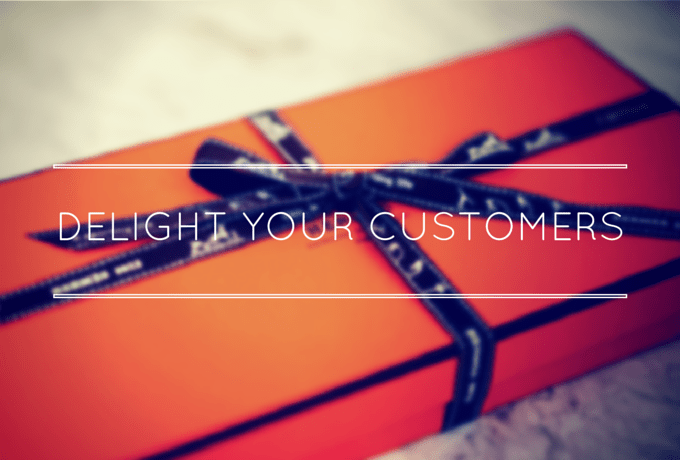
#1. Amazon
Amazon’s personalised recommendations system is a thing of online marketing legend.
We have all marvelled at one time or another at Amazon’s ability to intuit our product preferences. And we have probably all wondered how they seem to know everything about us.
No, they don’t have a super camera set up inside all of our computers.
They just have a really fancy algorithm that combines your previous search history with historical purchase data from similar users.
These personalised suggestions are a little kernel of surprise. Most of the time, you’re genuinely thankful to Amazon for the valuable advice. It’s not an irritating, interupptive promotion aimed at selling you more stuff. It seems like Amazon are just trying to give you nice heads up.
Like a friend might send you a link through email, or suggest something you might like in a conversation over coffee – Amazon is trying to help. They are doing their best to get to know what you like, and offer a suggestion.
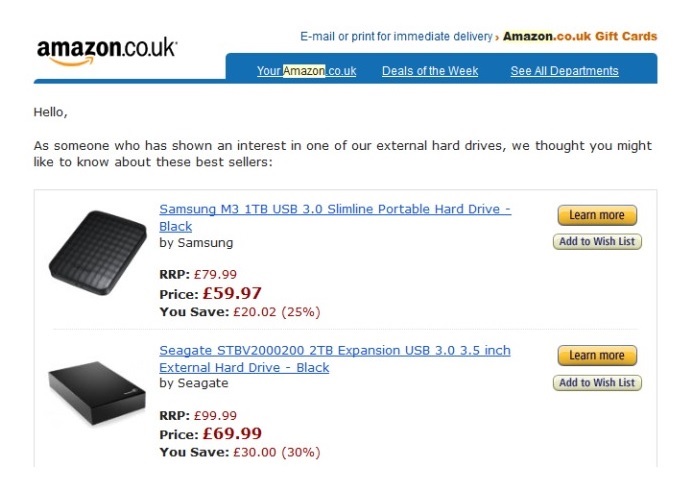
What makes this Amazon algorithm so good?
It’s not the technology.
It’s the helpfulness.
“Our mission is to delight our customers by allowing them to serendipitously discover great products,” an Amazon spokesperson told Fortune.
“We believe this happens every single day and that’s our biggest metric of success.”
The Lesson
Amazon has set out to give their customers the best possible online experience.
Every new innovation, like their famous Amazon Prime drone delivery service is designed to make our lives better.
When you start with the customer – not your profit – in mind, you start to earn their trust.
#2. Huckberry
If you’re serious about delighting your customers, you need to give them what they want.
Sometimes that might not always be what you want.
Sacrificing sales in the short term at the expense of your customer’s enjoyment, will most likely be made up for in the long term.
Trust wins out.
Huckberry is a retailer with a focus on practical outdoors wear that can withstand the rigours of a surfing trip, a camping weekend, or a night on the tiles after a hard day in the office.
Basecamp writer Emily Triplett Lentz recounts the Huckberry menswear revelation that nobody was talking to the dudes in the middle:
“You could find plenty of high-end designer products hardly anyone can afford, and plenty of hardcore performance gear that’ll help you summit Everest. But the options in between — the options for regular, active guys like them, who bike to work in the city and hit the trails on the weekend — were hardly anywhere to be found.”
Huckberry’s ecommerce business model is built on establishing genuine trust with its niche target audience.
The US menswear brand was developed for a specific bunch of blokes that share an outdoorsy lifestyle with a sense of style.
Huckberry’s founders didn’t source a bunch of great products and work out who they could sell them to. Instead, they identified a specific audience and worked out how to prove to these people that Huckberry should be their outfitter of choice.
Thus, delighting their audience was coded into Huckberry’s DNA.
And their business reflects this level of customer commitment.
One of the founders, Andy Forch, explains this customer-first approach to Ministry of Supply:
“Our mission is to inspire more active, adventurous and stylish lives through exclusive sales, original story-telling, and authentic experiences. When we’re considering a brand to feature or a story to run, we try to ask ourselves, ‘Is this central to our mission?’ I’ll be the first to acknowledge how hokey that sounds, but honestly, we do it.”
Huckberry started as a subscription based online magazine with 2 articles a week showcasing products perfect for the ‘Huckberry man’, along with the stories behind the products. They were just trying to create a service of helpfulness for their readers.
Now, the site is more like an online department store set up specifically for those ‘dudes in the middle’.
The homepage is split into categories and themes of products. It might be Spingtime footwear, minimalist rucksacks, Father’s day gift ideas, or casual wedding attire.
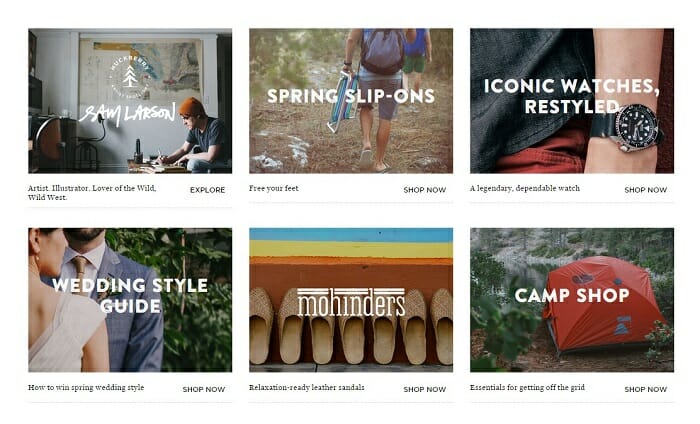
Andy thinks the decision to refuse venture capital funding, that continues to be thrust at the brand, has helped them build a sustainable future:
“Though we now have lots of inbound VC interest, we love the control that comes with bootstrapping as it allows us to focus on the long-game, which for us comes down to the 3 C’s: commerce, content and community. If we were a VC-backed company, I think content and community would take a backseat to commerce for short-term gains.”
Huckberry’s other co-founder, Richard Greiner touches on the ethos that has turned this brand from a couple of guys sending a bi-weekly email to a growing powerhouse with a high 7 figure revenue:
“We make decisions all the time that if you were an e-commerce guru, you’d hate Huckberry, We’re trying to get people’s mind share instead of wallet share. You’re building a relationship with these people. … Our mentality, that we are what we’re selling — people can really feel that and identify with that.”
Emma Triplett Lentz’s article hits the nail on the head:
“The idea is that even if customers aren’t interested in anything Huckberry is selling, they’ll still find value in the email, and the company.”
That famous newsletter is a perfect example. It’s ever-popular today, still a bi-weekly, with features on a bunch of select brands and stories that explain why they fit with the Huckberry lifestyle.
There’s blog posts from the acclaimed Huckberry Journal (you need to check this out if you are at all interested in ecommerce content marketing).
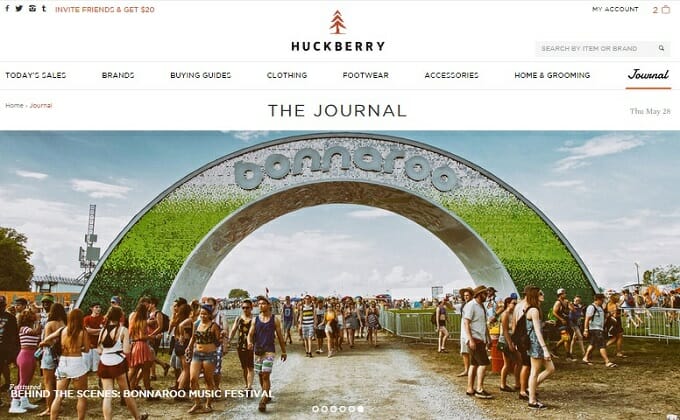
But, there’s also a section called ‘Diversions‘ that links out to other interesting stories elsewhere on the web. Any so-called ‘ecommerce expert’ will stress the best practice rule to never send your users off your site.
This commitment to customer helpfulness over cash seems to be working. Forch knows this is the reason customers open Huckberry’s emails at 5-10 times the rate they do competitors’ emails, as he explains in an interview with Thrive Wire’s Scott Bedgood:
“When Richard and I worked in investment banking, one of our favorite emails to receive was Weekend Sherpa, a guide to outdoor adventures in Northern California. The newsletter would hit our inbox each Thursday and it was like Christmas morning when we received that thing.
With Huckberry, we wanted to create a similar newsletter — one that would inspire our readers with cool, new products and stories. That’s the seed from which the Huckberry newsletter ultimately grew, and we still write as if we’re writing to that old version of ourselves — locked up in a cubicle and yearning adventure.”
The Lesson
If you fit the Huckberry audience sweet spot, their site is like an online gift shop, specifically designed for you! Browsing is fun. You feel like you’ve just found a little online candyland for yourself.
That’s how ecommerce should be. The gift-giving mindset etched into the brand’s constitution has created this incredible customer experience. It’s no fluke. And it’s something we all need to learn from if we’re to create lasting relationships and repeat sales.
You need to work out how you can give your customers that Christmas morning feeling again and again and again.
#3. Trunk Club
Who doesn’t enjoy that feeling of walking into a shop and being recognized, personally addressed, and treated as an individual?
Only shoplifters.
Everyone else surely loves it.
Even better when your favourite coffee shop knows your brew of choice. Or when your baker keeps aside your order incase everything else sells out.
It’s next-level when a retailer gets to know you to the point where they can personalise their offering based on the stuff they know you’ll like.
We need to start doing more of this in ecommerce.
There’s a spate of new personalised shopping services that are taking the internet by storm. Using the same kind of algorithm that makes Amazon’s suggestions so powerful to create a detailed ‘get-to-know-you’ questionnaire – innovative ecommerce brands are able to compile in-depth profiles of their customers before they’ve even purchased a product.
When you combine this personalised style dossier with the human skills of an expert stylist – you get ecommerce magic. And the ability to create personalised clothing boxes, delivered right to your customer’s door.
Trunk Club are doing it better than anyone else right now.
Nordstrom’s 2014 acquisition of the Chicago-based success story for US $350 million backs that call up just a little bit.
We’ve already gushed at length about Trunk Club’s personalisation heroics. We love them. You will too.
I’ll try and stay on task for this article’s sake though.
Trunk Club definitely know how to create that Birthday feeling.
Imagine, for a moment, a beautifully packaged box arrives on your doorstep. You know that waiting inside lies a collection of clothing excitement.
Each piece expertly selected from a plethora of high-quality, small-batch manufacturers you’d ordinarily never know to shop from.
Each item perfectly matched to your colour, style, and fabric preferences.
Each shirt sleeve, pant leg, and jacket cut fits like a glove.

You didn’t even need to lift a finger. If you like ‘em (and you will), you keep ‘em. If you don’t, you send the item in question back in the supplied prepaid package.
This is more than just convenience. It’s like having an online butler for your wardrobe.
Of course you want to order another trunk a little while later. You want that glee-inducing surprise to pop up on your doorstep. The more you buy, the more your stylist understands what you like, and the less likely you are to ever go to the trouble of shopping anywhere else again.
That’s why the gift-giving mindset leads to loyal, repeat customers. Go to the effort to truly understand what your customers want before they buy.
Focus on the person first – the sales will come later – but they’ll be repeated continually.
The Lesson
You don’t need to be at the top of the personalisation class with the likes of Trunk Club to reap the rewards. You just need to find a way to offer personalised services that show you care enough about your customers to learn their specific preferences.
Recent Econsultancy research shows that post-purchase loyalty programs with personalised offers are a significant driver of repeat purchase.
Noone is surprised here. Customer retention is all about trust, relationship and familiarity – the stuff that personalisation proves to the user.
Econsultancy’s research states that 74% of marketers know that personalisation increases customer engagement. The same study showed that only 19% of marketers are actually using personalisation.
Come on guys. We need to do better. We need to be more like Trunk Club.
#4. Birchbox
Birchbox got the memo.
They are firmly entrenched in the Econsultancy 19%.
They are almost like the Trunk Club of the beauty industry.
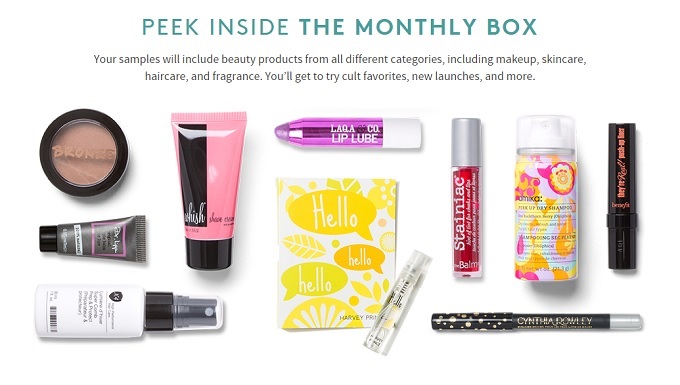
And if I know anything about beauty products (assuredly, this is fiercely debatable), it’s that people have a beauty ‘regime’. For the un-manscaped blokes out there, this isn’t a poorly spelt version of the thing you write when you apply for a job. It’s a regular routine used to make yourself look and feel better.
That means, people use – and need to buy – these products regularly.
And what did we just learn about repeat purchase and retention?
Personalisation helps to make it happen for you.
Birchbox seem to have worked this out quite some time ago.
They also seem to notice that all but the most attuned and committed beauty experts know exactly how and where to find the best beauty products to suit their features, complexion and budget.
So like Trunk Club, Birchbox set out to create a personalised beauty product subscription box service based on each customer’s skin color, hair type, age and favourite types of products.
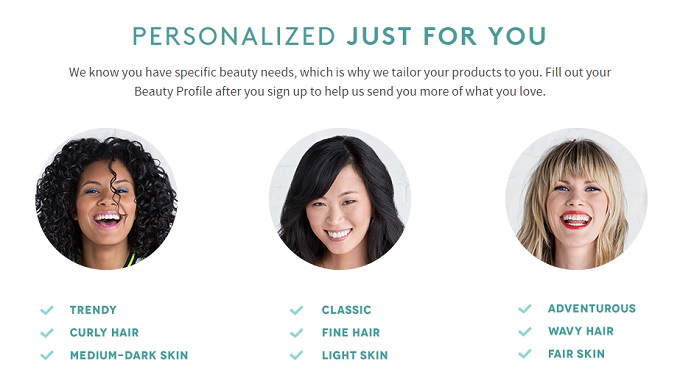
You sign up, fill out a questionnaire to establish your style profile, then wait for the magic combination of an Amazonian algorithm, and a human expert, to curate a box of beauty sample goodies that suits your beauty needs.
Said box turns up on your doorstep. You get to try a collection of new sample size beauty products you never would have found before. If you want to slot any into that regular regime, you set up a regular order through the Birchbox online store.
This model – it works. Erin Griffith, writing for Pando Daily, testifies,
as both customer…
“A few boxes haven’t delivered anything I really loved, but even then I hardly cared because I still got $10 worth of entertainment opening the box and examining its contents.”
…and analyst
“We pay, happily, to get boxes full of samples — all of which Birchbox sources for free. Brands are happy to give the company samples of their product at no cost, and in return get a chance at converting approximately 200,000 new customers… Half of Birchbox subscribers have converted into customers of its e-commerce site.”
This isn’t your regular old subscription box service. No generic box of stuff mailed out to every single subscriber once a month.
Co-founder Katia Beauchamp calls it discovery commerce:
“It’s a new term we coined because there isn’t a proper category that describes what we do. It isn’t subscription commerce because it doesn’t live and die by the box. It isn’t media because it makes money through the old fashioned selling of actual goods. It is really good marketing with a seamless transition to buy.”
Why is the personalised subscription box model growing with such voracity?
These companies know that today’s ecommerce customer has come to expect relevant, tailored experiences. Delivering on this expectation brings increased customer acquisition and loyalty.
Again, thinking customer-first, brings more repeat sales later.
The Lesson
Kevin Linsey, from Adobe Target, has a crack at explaining why the likes of Birchbox are the future of online retail:
“To overtake the competition, e-commerce sites must create compelling, relevant shopping experiences for every one of their customers. But the clear upshot is that personalization thrives in an e-commerce environment. It’s debatable that there’s no other type of website more innately aligned with the ins and outs of personalization than a shopping site.”
Lot’s of big words in there, but Kevin is bang on.
We e-retailers have no excuse.
We need to do better with personalisation.
And we need to turn that personalisation into customer delight.
#5. Netflix
When you think about ecommerce brands, Netflix doesn’t spring to mind.
Alas, they sell you stuff online. And they are very, very good at it. We think they are an ecommerce content marketing examplar.
Like Amazon, Netflix package up your viewing preferences into an algorithm-driven package of personalised suggestions.
The delightful gift comes in the form of an email, designed to help you find new shows that you might like, based on your personal viewing history.
Here’s a great example, courtesy of Business 2 Community:
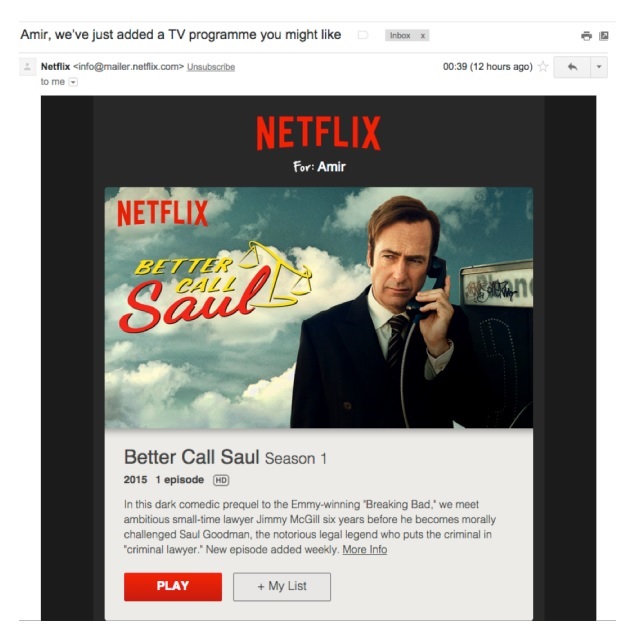
This is the opposite of the stereotypical ecommerce email spam that plagues so many of our inboxes.
Netflix subscribers love these emails.
Of course these personalised suggestions feel like a birthday gift pinging into your mundane online day.
You can’t wait to unwrap it and see what’s inside.
These folks have changed the way television works. They didn’t pull off this disruption with revolutionary technology or an unmatched chequebook.
They did it by learning as much as possible about their customers, then finding a way to give them what they want.
By providing a personalised experience – one that is predictive rather than reactive – Netflix can provide unrivalled value to their customers.
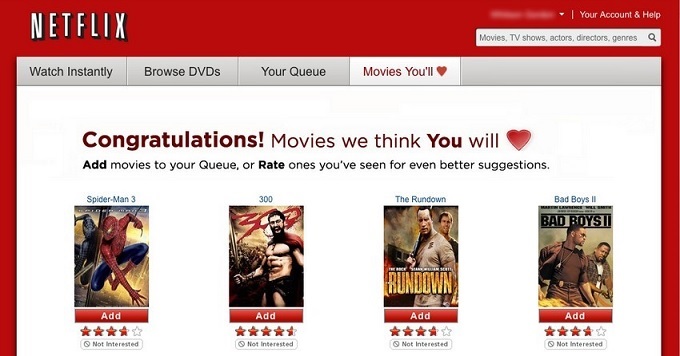
The more crowded our internet world becomes, the more value we place on services that strip away the guff and find us what we need. Mark Schaefer is an outspoken exponent of the view that great content marketing is not enough anymore.
“The amount of content on the web is literally exploding. By 2020, the amount of web-based information (most of it consumer-driven) is expected to increase by 600%. Think about that for a moment. If you can imagine the vastness of the Internet today, in six years we will have six of those.”
Consumers have the control now. We can’t set up our business to suit our own internal preferences.
If people want to binge-watch 20 hours’ worth of television in one day, you need to let them do that.
The Lesson
In the ever-increasing deluge of content, those that can offer a personalised ‘content filter’ will be at the forefront of customer experience.
Get to know what your customer wants inside their filter.
Help them bunker down against all that other annoying, interruptive internet noise out there (some people call it online advertising I think).
They’ll thank you for it with repeat purchases.
#6. Temple & Webster
Temple & Webster run homewares flash sales.
But this isn’t your ordinary impulse-triggered, scarcity-induced discount rush pedalled by another Groupon of the online world.
Instead of feeling like you’ve got five seconds to stealthily scoop up the factory seconds that have dropped off the back of a dying brand’s truck – Temple & Webster makes their homeware-obsessed customer feel like a kid in some sort of online homewares candy shop.
It’s kinda like Huckberry for interior design junkies.
Except T&W slash the prices of otherwise luxury-priced products from high quality manufacturers. Because Temple & Webster have such a huge group of trusting subscribers, these brands are falling over each other to offer their goodies at a relaxed price.
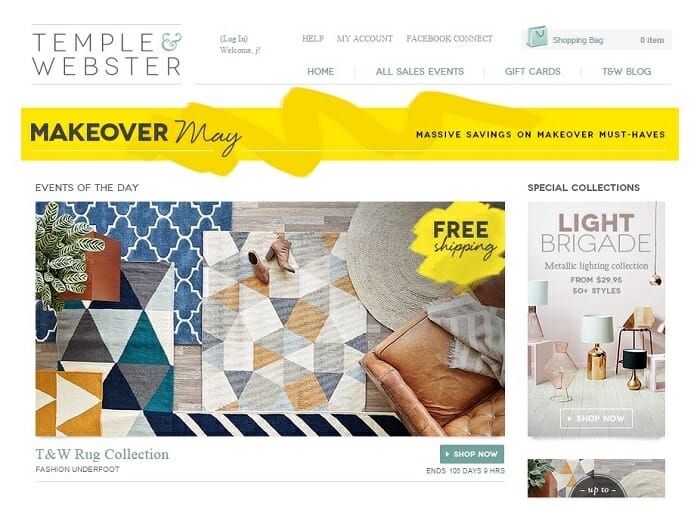
The sheer volume of orders that accompany a Temple and Webster sale allow for bulk discounts to be passed directly to the customer.
Here’s how T&W themselves explain things:
“Temple & Webster is a members-only, online shopping club. We’re dedicated to bringing our members elegant, beautifully curated collections of premium and designer brands for the home at member-only prices.
Each week we offer premium quality furniture and lifestyle products from both well-known and up-and-coming Australian and international designers. We also feature hand-picked curated collections from leading design commentators, interior designers, stylists and the designers themselves.
Temple & Webster shares the stories behind the brands. By bringing you these stories we take you behind the scenes, beyond the exclusive sales events, with a fresh, engaging outlook to inform, entertain and inspire.”
Temple & Webster customers virtually salivate in anticipation of their perfectly-styled email.
It’s a regular supply of exciting buy-a-gift-for-yourself ideas.
Instead of setting up another online catalogue of furniture retail options, these guys have crafted an experience that genuinely delights their customers.

The Lesson
You need to get to the point where your customers look forward to receiving your emails. Your subscribers should want to hear from you. Your audience should feel excited when they come into contact with your brand.
Set out to build these type of long term relationships.
Try to entice these type of emotions.
Your customers will start to see you as their ecommerce Santa Claus, instead of a boring old online store.
#7. Beckett Simonon
The Beckett Simonon story is one of inspiration for any aspiring ecommerce entrepreneur.
Not because they’ve skyrocketed to million-dollar success, or attracted huge venture capital funding.
No – more because these guys have kinda stuffed up a few times. They are so refreshingly normal. They could be you or I.
But they’ve still seen great success.
The reason Beckett Simonon is making it work is simple.
They’ve built a business based on what their customers want.
They’ve set up their ecommerce business model to make their customers excited to buy their products. They’ve established a gift-giving mentality to delight their audience.
The Colombian menswear startup set out to be the Warby Parker of the shoe industry. They saw retailers, wholesalers, and manufacturers; all taking their cut before the quality shoe reached the consumer.
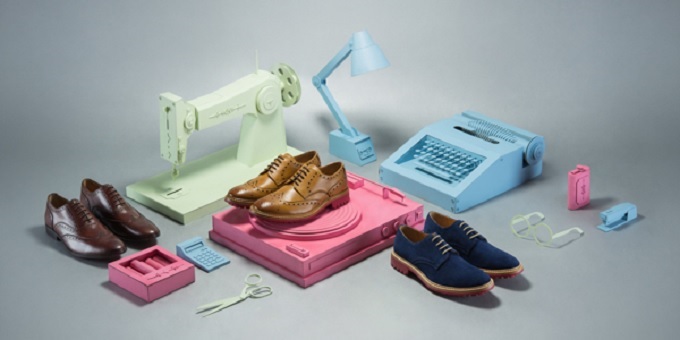
Co-Founder Andrés Niño tells Maxim:
“We were fed up with the high mark-ups that other shoes on the market were being sold for. We launched Beckett Simonon keeping quality and comfort in mind, but also with the intention of keeping prices down without sacrificing those two things.”
They knew that a well-crafted shoe could be half the price if the cash-grabbing middle men were banished.
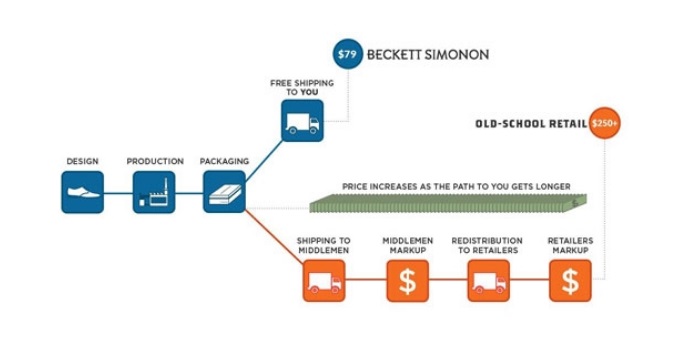
The Colombian-born duo at the helm of Beckett Simonon began manufacturing and selling an ever increasing range of shoes, with a relatively standard ecommerce business model.
What they found, however, were teething problems.
Manufacturing standards were hard to control. In an effort to squash down costs, the guys manufactured through Indian contractors. Results varied, with some customers experiencing significant problems and others questioning the brand’s ethical standards.
The team couldn’t keep up with demand. After featuring in a couple of popular publications, Beckett Simonon sold out. In the rush to pump out new products loose ends started to appear and customers, frustrated with their problems, were experiencing weeks of delay before hearing a response to their inquiries.
A key decision was made.
It was time for a radical rethink.
Things had to change if the business was to succeed.
Beckett Simonon decided to rebuild their business model into a customer-crowdfunded product range. To ensure the best possible quality, at the lowest possible price, with optimal customer service, things needed to be streamlined.
Here’s Nicholas Hurtado, one of the Co-Founders, explaining the new measures to a thread of irritated customers venting on Reddit.
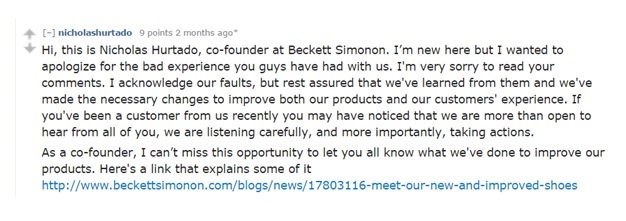
This new strategy allowed Beckett Simonon to ask customers what they wanted most, then focus on creating the best possible version of that product, with the insurance policy of a base level of presales.
Here’s the current crowdfunded product Beckett Simonon are focusing on:

Rather than offering 20 decent shoes every season, now there were just 4. Each were a rendition of a classic style that most customers would enjoy. The retailer was able to deliver the quality standard they originally set out to achieve
B&S explained their new approach to their subscribers in this blog article just after their re-launch:
“These new shoes are made in tropical and sunny Colombia. After manufacturing in India, we learned that responsible manufacturing is a big deal. Our new factory is family owned and operated, and our products are made with high quality and locally sourced materials.”
And why crowdfunding? We want to give you outstanding products and the best bang for your hard earned buck. Keeping inventory is a very expensive endeavour that increases the risk for ecommerce brands and traditional retailers, these costs are included in the final markup and therefore you end up paying them at the end. By avoiding these extra costs we are able to give you the best quality at an unparalleled price.”
Keeping inventory is expensive and risky.
Crowdfunding is one of the best ways to provide the best possible quality for the lowest possible price.
It’s also a great way to give your customers a voice in your product development. You’re eliminating things that your audience doesn’t like. You’re concentrating 100% of your focus on already-vetted products.
If your subscribers are invested in your product before it exists, they feel like they are playing a part in its development.
You’ve created an emotional attachment.
Your backers want to see that product succeed.
When it does, and you deliver the goods, of course it feels special.
Your customer has already committed to the product, and when they receive it, there’s a sense of pride and satisfaction that comes along with it.
The Lesson
There’s a new model that helps you bootstrap an ecommerce business to fast growth.
Focus on a small number of popular items and make your version as valuable as possible.
Prove that your version on the classic is the best. Do it with your content.
Crowdfund development.
Deliver gifts to expectant bankrollers.
Earn trust.
Repeat the process.
#8. Field Notes
Field Notes are another Gorilla content marketing favourite. I’m an unabashed fan-boy too.
I write stuff everyday, and like many creators, I find the creative juices flow more freely onto the page than the screen. So you’ll never find me without a notebook in my back pocket – and Field Notes is my weapon of choice.

Why do I chose Field Notes?
Sure the paper quality is great, and the materials used make these bad boys exceptionally durable. They’re US manufactured, but that doesn’t mean much to me back in Aus (apart from more expensive shipping).
I don’t buy Field Notes for the product features – I buy Field Notes because I love the brand. They believe in the same things I do. They care about crafting creative ideas. They care a quality handmade goods. They care about great design. So I pay a little extra to buy their books, because I feel good while I’m using them.
The secret of Field Notes’ customer delighting lies in their breathtaking content marketing.
They make manufacturing notebooks seem magical.
Don’t believe me?
Watch and learn…
There’s plenty more where that came from on the Field Notes blog.
But these Notebook Merlin’s really excel in conjuring spells of customer delight with one simple ecommerce masterstroke.
Just like your favourite, newspaper, magazine or television show, Field Notes understand that people love an ongoing segment that’s part of a larger continual story.
It’s something to look forward to.
It’s something to keep coming back for.
It’s something you don’t want to miss out on.
The Field Notes ‘Colors’ concept is a content marketing series masterpiece.
Since Winter 2008, quarterly Field Notes Colors Packs are released, as limited-edition variations on the classic memo book. The Colors series explores new papers, printing processes, and colours, sometimes adding special packaging and other fringe benefits, with a new variation on a theme relating to each season.
Field Notes Colors Packs are sold in small quantities. As such, they often sell out moments after they’re announced to the brand’s rabidly passionate subscriber list.
Again, breathtaking Field Notes video is the best way to explain:
As you can imagine, fans wait for each season’s release with unbridled anticipation.
The video reveal is like a beautiful gift unwrapping ceremony.
So Field Notes developed a subscription model, allowing those passionate notebook nerds to avoid their FOMO, and save them from the anxiety of uncontrollable browser refreshing mayhem when the product is released to the masses.
By guaranteeing delivery of a year’s worth of new Colors notebooks, Field Notes are perfectly forecasting a baseline of demand, guaranteeing repeat purchase, and delivering their customers a quarterly gift.
What an online retail dream.
The Lesson
Can you create an ongoing subscription based series that keeps getting better and better and better?
Can you find a way to make your customers so excited for a new product release that they sign up one year in advance?
Can you make you subscribers so excited about your content they want to regularly buy your stuff?
You can.
If a notebook retailer can generate that level of excitement, you have no excuse.
Make your customer’s experience feel like a birthday surprise

That subheading is to moral to this story.
I’ve explained 8 different methods that online retailers are using. They are all based on the same success-delivering concept.
- Get to know each and every potential customers as well as you possibly can
- Do it before they buy
- Proactively find out what they want
- Find a way to make your products seem like a birthday surprise
- Repeat
Create a customer service experience that forces your audience to come back for more.
You’ll get a gift in return – loyal repeat customers. The best kind.